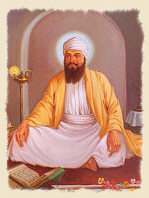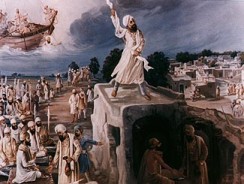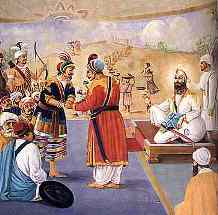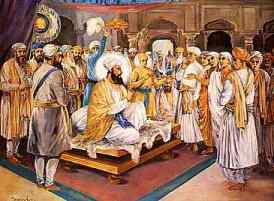Sikhism - Sikh Gurus - Guru Tegh Bahadur
'Baba Bakale', was the only clue given by Guru Har Kishen for his successor. As this word reached the village Bakala, twenty-two Sodhis including Baba Dhir Mal, the grandson of Guru Har Gobind, set up their shops and claimed themselves as the ninth Guru.

The Sikhs were in great confusion as they could not know who the real Guru was. Makhan Shah Labana of Jehlem district was a trade merchant. When his vessel full of merchandise was sinking, he had invoked Guru Nanak and had vowed to offer five hundred gold mohars (coins) if the vessel reached the shore safely (some say that he vowed 101 gold mohars). Makhan Shah came to the village of Bakala to pay his offering to the Guru. He was surprised to find that twenty-two Sodhis had installed themselves as Gurus. In that state of confusion and uncertainty, he resolved to try the Pretenders. He thought to put two mohars before each impostor and the real Guru being the searcher of hearts, would ask for the balance of his promised offering. He visited all the 22 impostors and made each of them offering of two gold mohars, but none of them asked for the balance.

'Baba Bakale', was the only clue given by Guru Har Kishen for his successor. As this word reached the village Bakala, twenty-two Sodhis including Baba Dhir Mal, the grandson of Guru Har Gobind, set up their shops and claimed themselves as the ninth Guru. The Sikhs were in great confusion as they could not know who the real Guru was. Makhan Shah Labana of Jehlem district was a trade merchant. When his vessel full of merchandise was sinking, he had invoked Guru Nanak and had vowed to offer five hundred gold mohars (coins) if the vessel reached the shore safely (some say that he vowed 101 gold mohars). Makhan Shah came to the village of Bakala to pay his offering to the Guru. He was surprised to find that twenty-two Sodhis had installed themselves as Gurus. In that state of confusion and uncertainty, he resolved to try the Pretenders. He thought to put two mohars before each impostor and the real Guru being the searcher of hearts, would ask for the balance of his promised offering. He visited all the 22 impostors and made each of them offering of two gold mohars, but none of them asked for the balance.
Guru Tegh Bahadur was the fifth and the youngest son of Guru Har Gobind and was born on first of April, 1621 to Mata Nanaki at Amritsar, Guru ke Mahal. He was married to Mata Gujri, daughter of Lal Chand of Kartarpur in Jullundhur district. After Guru Har Gobind, he with his mother, Mata Nanaki and his wife went to live in Bakala.
Guru's Visit to Amritsar
When Guru Har Gobind shifted his headquarters to Kiratpur, most of his disciples had also moved to that place with him and the Golden Temple at Amritsar fell ultimately into the hands of the impostors like Harji Minas. In November 1664, Guru Tegh Bahadur went to Amritsar. He bathed in the sacred tank but the Pujaris (or the ministrants) closed the doors of the Har Mandar against him. He saluted it and remarked that it was they who were rotten within, who through greed of offerings, had entered the temple. When the news spread, the people of Amritsar went in a body and poured their souls at his feet. The women of the city took the lead, welcome him with the Guru's hymns and went with him singing all the way to the village Wadala (or Walla) where he stayed in the humble abode of a devout disciple. The Master blessed the women of Amritsar and Amritsar itself. On seeing their devotion he blessed them with these words,"God's love and devotion shall ever abide among you."
Foundation of City of Anandpur
Leaving Amritsar the Guru passed through the Majha and Malwa regions before reaching Kiratpur sometimes in May, 1665. He attended the last rites of Raja Dip Singh of Bilaspur and expressed his desire to build a new settlement near Kiratpur and also showed his inclination to buy a suitable land fo that purpose. The Rani of Bilaspur offered to donate the site of Makhowal.
The offer was accepted, a token price of about five hundred rupees was paid. The foundation stone of new settlement, Chak Nanaki was laid in June, 1665, after the revered name of Guru's mother. In the course of time, a beautiful town called Anandpur grew up around it.
Guru on missionary tour
After founding the new settlement, the Guru did not stay there long. However he entrusted the construction work to his trustworthy followers. The Guru left Anandpur in August, 1665.
After leaving Anandpur he passed through Ghanauli, Rupar, Dadoomajra and Lung village and then reached Mulowal in Patiala state. He then proceeded to Pharwali, Handiaya, Bhandehar, Khiwa and Bhikki. He gave religious instructions wherever he stopped and instructed the people not to worship idols and tombs, but worship only One God, the Formless. He passed through the villages of Dhaleo, Alisheir, Khiala and reached Maur where he was awaited by a great concourse of people to whom he preached true Name.
The Guru then proceeded to Tekpur and he stayed for a few days in the house of a carpenter who conducted him as far as Kaithal. He reached Barna and preached here against the use of tobacco. The Guru reached Kurukshetra on the occasion of solar eclipse. He was received with great honor and distinction by all the holy men present there. Then he crossed the Jamna river and reached Kara Manak.
From Kara Manak he proceeded to Mathura and reached Agra. There is a Gurdwara to symbolize his visit. Through Itawa he reached Kanpur where there is a Gurdwara at the bank of the Ganges. Then he reached Priyag (Allahabad). The Guru's mother told him that her late husband Guru Har Gobind, had promised that a great being would be born in the house of Guru Tegh Bahadur and so she was awaiting for that event. He replied that her desire would soon be fulfilled but she had to meditate continually on Guru Nanak. He stayed about six months at Priyag and to the great joy of his mother, his wife got pregnant. From Priyag he proceeded to Mirzapur where there is a Gurdwara on the bank of the Ganges. He reached Banaras (Kashi) and stayed in Resham Katra where a Gurdwara marks the memory of the Guru. Hundreds of people came to behold him.
The Guru then reached Patna and encamped at first in a garden outside the city. That place is called Guru ka Bag. Bhai Jaita, a devout disciple, took the Guru to his residence. The Master gave religious instructions to the people. One day he told his mother, Mata Nanaki that many Sikhs were waiting for him in a distant land, so he must go to them. He wanted the family to remain at Patna. On their remonstrance the Guru told his wife," The prophecy of my father is now about to be accomplished. A son shall be born to thee, who shall be great and powerful, extend the faith, establish Sikh supremacy, root out the wicked, and destroy the enemies of truth and true religion. You would suffer great hardship in travelling, so be happy here." He offered words of consolation to his mother and wife, thus, entrusting them to his brother-in-law Kirpal Chand, bade farewell and proceeded to Munger, Bhagalpur and Rajmahal.
He arrived at Maldah where he stayed with a Sikh who was a confectioner. From there he went to Murshidabad and next halt was at Dacca. While in Assam he also visited Cooch Behar, Chander Bhanga, Kishen Ganj and Purnea.
Aurangzeb's campaign of religious persecution
As Aurangzeb ascended the throne of India by imprisoning his father and murdering his brothers, he decided to enlist the sympathies of the fanatical section of his co-religionists. His idea was to exterminate the idolatrous Hindus and to convert the whole of India to Islam. In order to achieve this objective he tried to go through four fundamental means to deal with the Hindus. Firstly he made peaceful overtures; secondly he offered money; thirdly he threatened punishment and lastly he tried to cause dissention among them. When all these measures failed, he resorted to forcible conversion. Orders were issued to the governors of all the provinces that they should destroy the schools and temples of the infidels and thereby put an end to educational activities as well as the practices of the religion of the Kafirs (non-Muslims meant Hindus). Many temples at Mathura and Banaras were destroyed. Even a Sikh temple in Buriya in Khizrabad pargna of Sirhind had been demolished and a mosque was built on the site. Some Sikhs, however, attacked the mosque and killed the priest. This type of incidents had become common occurrences. In order to force conversion to Islam, all possible means were adopted. In the field of taxation, the policy of discrimination was launched with great vigor. Jaziya and pilgrimage taxes were re- evied. Five percent custom duty was levied on the Hindus while the Muslims were charged only half of that.
 |
 |
The proselytizing zeal of the officials, with their campaign of religious persecution and their conversion at the point of the sword, had sent the wave of terror throughout the country. Sher Afghan Khan, the Emperor's viceroy in Kashmir, set about converting the Kashmiri Hindus by force and massacred those who opposed to embrace Islam. Even the Mohammadans who in any way assisted the Hindus, were mercilessly put to death.
Kashmiri Brahmans come to Guru
A deputation of Kashmiri Pandits (Brahmans) came to Anandpur and among tears of agony, they narrated their tales of woe and suffering to the Master. The Guru's eight years old son appeared on the scene and asked his father why those people had tears in their eyes. He replied," The Emperor of India is converting the Hindus to Islam at the point of the sword and thus there is no end to the misery of these people."
"What is the remedy, father?" asked the son.
The Guru replied," This requires sacrifice- sacrifi ce of a holy and supreme soul." His son responded," O dear father, who is more holy than you in this age? Go and offer yourself and save these people and their religion." On hearing this the Guru asked the Kashmiri Brahmans to go to the Emperor and make the following representation to him," Guru Tegh Bahadur, the ninth Sikh Guru is now seated on the throne of the great Guru Nanak, who is the protector of faith and religion. First make him a Musalman and then all the people, including ourselves, will of our own accord adopt the faith of Islam."
Guru summoned to Delhi
The Pandits obeyed the Guru and conveyed the proposal to the Emperor. On hearing this proposal, the Emperor was very much pleased because he thought that it was much easier to convert one person than the whole lot. He retorted," If the Guru does not become Musalman, he will then at least show us a miracle." He was hopeful that once the Guru was converted, there would be a large accession of Hindu and Sikh converts. The Emperor, therefore, sent his emissary to the Guru to invite him to Delhi. The Guru received Emperor's message and wrote in reply that he would come to Delhi after the rainy season.
Martyrdom of Guru Tegh Bahadur
After the rainy season, the Emperor again sent his messenger to hasten the Guru's presence to Delhi. When the messengers were unable to find the Guru, they reported that he had fled. Orders were issued all over the empire to find and arrest him. There are different views about the place of Guru's arrest. There are different views about the place of Guru's arrest. According to Sikh accounts there lived a poor old man, Hasan Ali, at Agra. He knew that there were orders about Guru's arrest and the person who could effect his arrest, would receive one thousand rupees as a reward. Hasan Ali prayed," O true Guru, if ever you want to get arrested, please do it through me. This will fetch me some money to bring my family out of the clutches of miserable poverty." The Guru being the searcher of hearts, came to Agra to get arrested through Hasan Ali.
Ultimately he was brought to Delhi. There were three Sikhs, Bhai Mati Das, Bhai Dayala and Bhai Sati Das with the Guru (Some writers account for five Sikhs- Mati Das, Gurditta, Uda, Chima and Dayala) who were arrested with him and were brought to Delhi.
It was ordered that the Guru be imprisoned with sufficient guards around him as he did not embrace Islam when asked by Aurangzeb. Again he was sent or and was told that if he embraced Islam, every service would be performed for him otherwise he would be severely tortured. He replied that he would never embrace Islam and thus, remained in Delhi jail for eight days. He was given three choices: firstly to embrace Islam; secondly to perform a miracle; and thirdly to prepare himself to court death. The Guru responded that to show a miracle was against the Will of God and thus he would not consent to the Emperor's proposals and the Emperor might act as he pleased. He was then put to extreme tortures.
It is said that there was conversation between the Guru and his disciple Bhai Mati Das. He told Mati Das that Guru Nanak had blessed Emperor Babar with the continuation of his empire for a long time. Since the Mughal Emperors started committing great enormities, their line would be exterminated if he (Guru) laid down his life. In consequence of this conversation which was overheard by a priest, Bhai Mati Das was bound between two pillars and his body was sawn asunder. When the executioners put saw on his head, he began to recite Japji (the first Bani in Guru Granth Sahib). It is said that when his body was cut into two, he continued reciting Japji and he was silent only when the recitation of Japji was complete. This was a wonder of Guru's Grace. Bhai Dayala was boiled to death in a cauldron of hot water. It is said that the third companion Bhai Sati Das was roasted alive with cotton wrapped round his body. The authorities thought that these tortures of his Sikhs might shake the Guru. Nothing could and nothing can shake the Divine Light (the Guru).
The final message was given to the Guru," You are to accept the religion of Islam or show a miracle. If you work a miracle, you may remain a Guru. If you accept Islam, then you will be advanced to an exalted position. If you fail to accept these offers, you shall be put to death. This is the final decision."
The Guru emphasized," I will never abandon my faith. I want no honor in this life; I want honor hereafter. The threat of death possesses no terrors for me. For death I am prepared and I cheerfully accept it."
Hearing this reply it was ordered that the Guru should be executed. Saiyid Adam Shah accompanied by courtiers and Muslim priests came with a warrant for his execution. Many people turned out to witness the execution. He was then taken out of his cage and allowed to perform his ablutions. He sat under the banyan-tree where he recited Japji. The executioner, Jalal-ud-din of Samana (some say it was Adam Shah) took his sword and in a split of second, severed Guru's head from the body. This happened on the afternoon of Thursday, the fifth day of the light half of the month of Maghar in Sambat 1732 (November 11, 1675) at Chandni Chowk, Delhi where now stands Gurdwara Sis Ganj in his memory. This Gurdwara was constructed by Sardar Baghel Singh Karor-Singheiye in 1790.
History has recorded that a furious storm raged immediately after this brutal deed which filled every one's eyes with dust. Bhai Jaita dashed out of the crowd and instantaneously took away the holy head of the Guru to Anandpur. He reached Kiratpur on the 15th of November, 1675. From there the Guru's head was taken to Anandpur with full honor and on the 16th of November, 1675, it was cremated with full ceremonies. There is a Gurdwara called Sis Ganj at Anandpur where the hallowed head of the Guru was cremated. The tenth Guru received Bhai Jaita who belonged to backward classes, embraced him and said," Rangrettei Guruke bettei" (Rangrettei were the sons of the Guru, Rangrettei was Bhai Jaita's caste). Bhai Jaita told the young Guru and his family how Guru Tegh Bahadur had sent for five paise and a coco- nut and bowed to his son Gobind Rai, made him the successor and infused his Light unto him.
Lakhi Shah Labana was a famous contractor in Delhi and he was also a follower of the Guru. He emptied his carts laden with lime near the Red Fort, taking advantage of the darkness and the carelessness of the Mughal sentries, and with the help of his sons, Nagahiya, Hema, Harhi and his friend Dhuma, whisked away the sacred body of the Guru, in one of their carts. Apprehensive of the government reprisal, Lakhi Shah and his sons then built up a pyre inside their own house and set fire to it. When the body was duly reduced to ashes, they cried out that their house had caught fire and called upon their neighbors to assist them in extinguishing it. Next day they collected the Guru's remains and buried them in a copper vessel called 'gaggar' in the earth under his funeral pyre. On this spot there stands a Gurdwara, Rakab Ganj, near Parliament House in New Delhi.